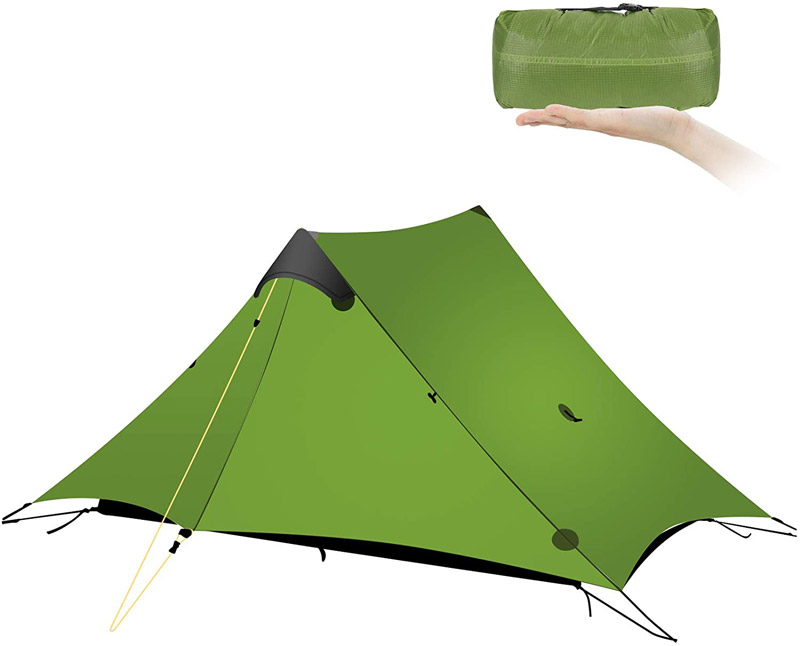Tents
The Best Trekking Pole Tent
When it comes to venturing into the backcountry, pack size and weight are major considerations. For most, your tent or shelter is the most substantial item, so any opportunities to cut down and simplify are vital.
Tents come in all shapes and sizes, but for venturing deep into the woods a trekking pole tent adds another level of practicality for your trip.
In this article we will dive into what a trekking pole tent is, which main factors to consider when looking to purchase one, plus the pros and cons versus a regular tent setup.
We will also review a mix of hiking pole tent options to help you determine which style will be best suited to your outdoor adventures.
The Quick Takes:
• Best Wet Weather: KikiLive Ultralight Tent
• Best Entry-Level: Fltom Trekker Tent
• Best Versatility: MIER Ultralight Tent
• Best Overall: Six Moon Designs Lunar Tent
To jump into the details, scroll down for a better look!
What is a hiking pole tent?
A hiking pole tent (or trekking pole tent) is a tent designed in a way where your hiking poles are used in place of tent poles in order to cut down on weight, packed tent size and overall reduce excess gear carried into the field.
Although you can get tents where the outer tent doors are designed to be held open by hiking poles, we are going to focus on those that incorporate the trekking pole into the actual structure of the tent. These tents are able to nearly eliminate any need for tent poles.
Since these tents do not need technology and production put into the tent pole structure themselves this gives the buyer the opportunity to get an ultralight backpacking tent, at a reasonable price.
Regular tent vs trekking pole tent
Regular tents usually have tent-specific poles running through them. These are sometimes also referred to as freestanding tents, as the built combination of equipment gives the tent its structure.
Trekking pole tents, sometimes known as non-freestanding tents, are different in the way that they retain form. Whilst the hiking poles give height and basic structure, pegs and guy-lines are usually required to tension out the walls of the tent to give it shape.
Trekking Pole Tent Pros:
• Usually smaller in pack size and lighter in weight due to removal of excess tent poles.
• Overall reduction in gear. Multi-purpose use of hiking items. Minimalism.
• Generally at a more affordable, cheaper cost as they do not require specifically designed tent poles.
Trekking Pole Tent Cons:
• Trekking poles used by tent, which means day hiking from camp you need to either remove poles from tent, or hike without poles.
• Usually not as structurally sound as a fully incorporated tent design. Less stable against heavier winds and snow.
• A little more effort to set up as it requires tension from guy-lines, rather than being a complete freestanding unit.
Why not just a tarp tent?
Tarp tents can be a great, easy, light backcountry option for adventurers hiking long miles, with minimal gear.
Whilst this minimal approach my be good for the hiking, it lacks in the aspects of security and protection. As they are less enclosed they have greater issues with wind, bugs and other animals.
Whilst tarps are waterproof in material, there is also the consideration of flowing water during heavier rains, as they often come without a base. This is the kind of tent best suited to ideal weather conditions, and a camper who is really comfortable with “roughing it”.
Factors to consider
When it comes to finding the right tent for you, there are certain factors you need to consider. We will take a look at a few different categories, what they mean and what to look for.
Capacity
One of the major factors as to overall size and weight of a tent is its capacity. The capacity of a tent is how many persons it is designed to sleep, within some level of reasonable comfort.
The greater the size of the tent space, the more material needed. When it comes to determining what size tent you require, you want to generally limit to the number of people who are going to be using it at any given time, as to not take on unnecessary weight.
One exception to this may be if you are not traveling a large distance, but are spending a reasonable amount of time in a single location. If able to carry the extra weight, the slightly larger tent improves its livability as you have a little more space for spending longer stints in the tent; through evenings or rainy weather.
Weight
It’s not uncommon when venturing into the backcountry to have to carry every ounce of gear, food or creature comforts on your back. Your tent is one of the main contributors to your overall pack weight, and size, so any opportunity to shed weight is important.
We have already acknowledged that hiking pole tents are generally lighter than their freestanding counterparts, however between different tent designs, companies and price ranges you can still find reasonable differences in product weight between trekking pole tent options.
Weather Resistance
The importance of this is definitely dependent upon the climate of the areas in which you camp. Although most tents come with some level of waterproofing, some are better than others. This becomes an important consideration especially living in areas with regular rainfall, snow, winds or cold temperatures.
Not only does waterproofing on the outer layer matter when it comes to active rainfall, but a level of water resistance on the base is helpful when the ground is damp, snowy or water is flowing in and around the campsite. Then you or your gear gets wet, it does not make for a pleasant camping experience.
Setup
Hiking pole tents generally do not have with an integrated tent pole system, which can both be a positive and a negative when it comes to the complexity or time to set up the tent.
Whilst regular tents may be a little more finicky to follow the instructions, getting the right items in the right spots, in the right order; hiking pole tents are different.
Usually easier to open up and set up in a basic sense, these tents can however require a bit of extra work to achieve the right tension on the guy-lines to give the tent structure and stability. Basic tent structure, guy-line and peg locations will play a part in the level of ease (or challenge) of setting up your tent effectively.
Versatility and Comfort
The way in which a tent displays its versatility can in a variety of forms. Most aspects of versatility and comfort come down to overall construction and design of the tent.
Major comfort considerations include the overall space within the tent, considering length and width for adequate space to sleep, especially with two or more persons, as well as height for room to be able to sit up and organize yourself within the tent.
Versatility factors include aspects such as the ability to use the shell and the inner tent independently, depending on conditions and purpose. Many of these trekking pole tents have the ability for the shell to be set up as a tarp tent or basic shelter. Door size, number of access points and the addition of vestibules all become valuable in different circumstances.
Price/Value
Finally, price. Cost of goods is a considering with any product you are looking at, not only for the outright expense of the product, but also value for money.
When weighing up between different tent options you want to weigh up the benefits and drawbacks of each tent, against how much you are going to use it, and how it fits within your budget. The best product for the best price is usually the name of the game.
Best Options For Hiking Pole Tents
KikiLive Ultralight Tent
Key Features:
| Capacity: | 2 Person |
| Weight: | 3.3 lbs |
| Floor Size: | 6.9 ft x 3.6 ft |
| Material: | Nylon, Polyurethane |
| Weather: | Waterproof (8000mm base, 5000mm shell) |
| Extra Features: | Rainfly zipper flap, ventilation windows, separate setup ability. |
| Price: | $149.99 |
Additional Thoughts:
The most waterproof of the tents in this article, the KikiLive ultralight tent has put special considerations into ensuring the weather-resistance of this tent.
Beyond the strong waterproof shell, the even more waterproof base, additions such as zipper flaps and taped seams have been incorporated into the design to minimize leakage around vulnerable points of the rainfly.
This tent does come with doors on both sides of the tent, however it may be a little snug inside for two campers given the smaller footprint dimensions compared to others on the list.
In a Nutshell: Best tent for camping in rainy conditions
Six Moon Designs Lunar Tent

Key Features:
| Capacity: | 1 Person |
| Weight: | 1.7 lbs |
| Floor Size: | 7.5 ft x 4.0 ft |
| Material: | Silcone-coated polyester |
| Weather: | Waterproof (3000mm), wind-resistant design |
| Extra Features: | Floating floor, adjustable canopy height, oversized door, ventilation |
| Price: | $250 |
Additional Thoughts:
The Six Moon Designs Lunar single person tent is a premium product in that it is an ultra lightweight option, whilst still maintaining aspects of space and livability. The shape of the tent and floor plan itself adds room comparable to that of a two person tent, allowing the user to maximize on comfort when venturing alone into the backcountry.
This tent is also primarily pegged down, only using the need for guy-lines to support in more extreme conditions, making it relatively easy to set up and tension down.
In a Nutshell: Lightest tent for deep solo missions
OneTigris Tangram Tent
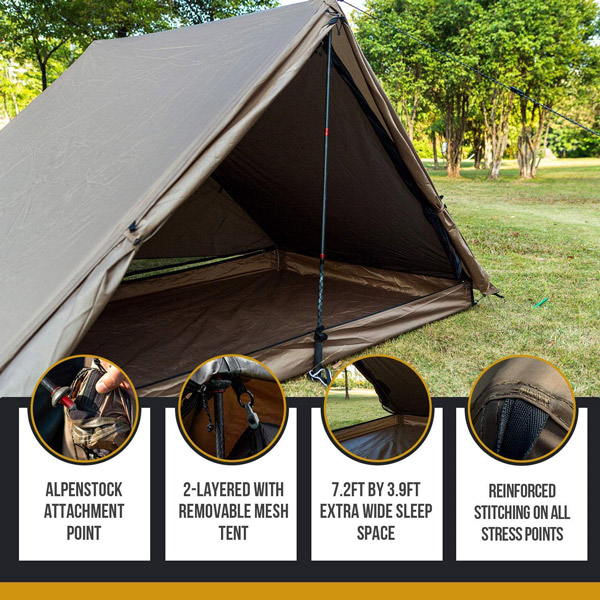
Key Features:
| Capacity: | 2 Person |
| Weight: | 4.0 lbs |
| Floor Size: | 7.2 ft x 3.9 ft |
| Material: | Ripstop nylon |
| Weather: | Waterproof (1500mm) |
| Extra Features: | Adjustable height, double doors, durable. |
| Price: | $159.98 |
Additional Thoughts:
The OneTigris Tangram tent is a little weightier than other options in this list, however that does come at the benefit of durability.
This tent has a sturdy build, with a large opening doors on either side of the tent, making for a comfortable in-camp experience, allowing space to move around, and easy access to your sleeping quarters.
The tent is great for missions that may benefit from a little extra durability, such as set ups in heavily timbered areas (falling debris), hunting trips and alike.
In a Nutshell: Durable material for rugged or frequent use
Mier Lanshan Tent
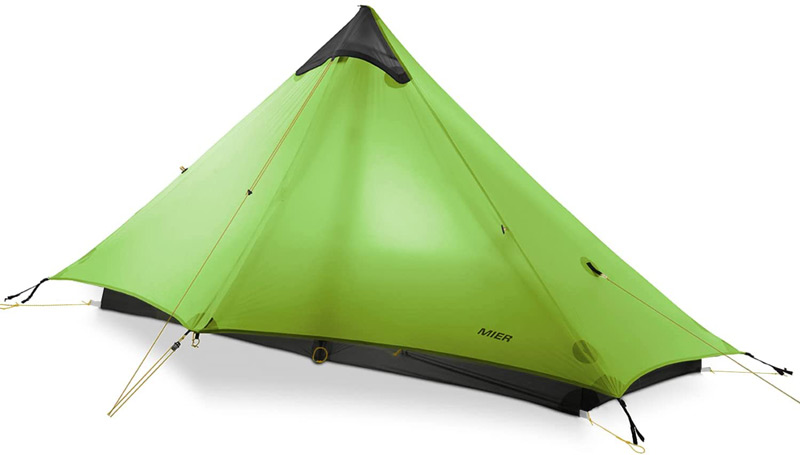
Key Features:
| Capacity: | 2 Person |
| Weight: | 2.8 lbs |
| Floor Size: | 7.2 ft x 3.6 ft |
| Material: | Ripstop nylon w/ silicon-polyurethane blend |
| Weather: | Waterproof (5000mm) |
| Extra Features: | Outer fly and inner mesh can be set up separately for versatile tent configuration. |
| Price: | $169.99 |
Additional Thoughts:
Similar in look to the KikiLive tent listed above, this tent has a few key differences. The Mier Lanshan tent is slightly longer in footprint length, and slightly lighter on weight, however the base is not quite as waterproof. That said, the overall waterproof rating of this tent is still rather impressive.
This tent has decent ventilation points on both sides of the canopy, taped seams for additional weatherproofing, and can be set up as either outer shell only, inner tent only, or both combined to make a fully fledged tent.
In a Nutshell: Versatile lightweight choice for varying conditions
River Country Trekker Tent
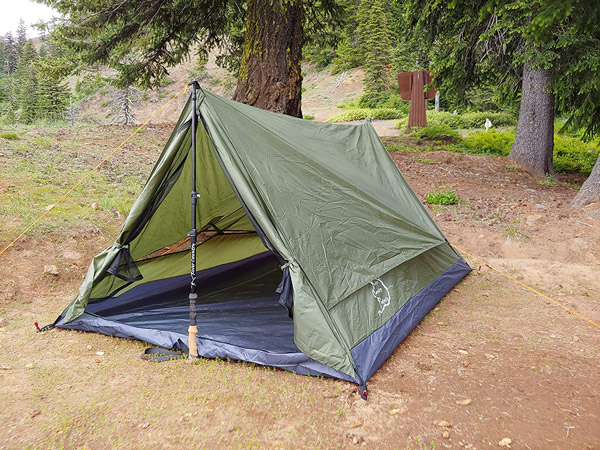
Key Features:
| Capacity: | 2 Person |
| Weight: | 3.3 lbs |
| Floor Size: | 7.0 ft x 5.0 ft |
| Material: | Polyurethane-coated polyester |
| Weather: | Waterproof (2000mm) |
| Extra Features: | Spacious sleeping space, large entry point |
| Price: | $65.95 |
Additional Thoughts:
An entry-level tent with basic waterproofing, this River Country tent focuses on giving the camper extra room to move with over a foot of extra width compared to most other tents on this list.
This tent runs at a reasonable height and has large opening doors on the front. The drawbacks however are that this tent does not come with a vestibule, and may no perform as well as others in varying weather conditions.
In a Nutshell: Budget option with plenty of room
Fltom Trekker Tent
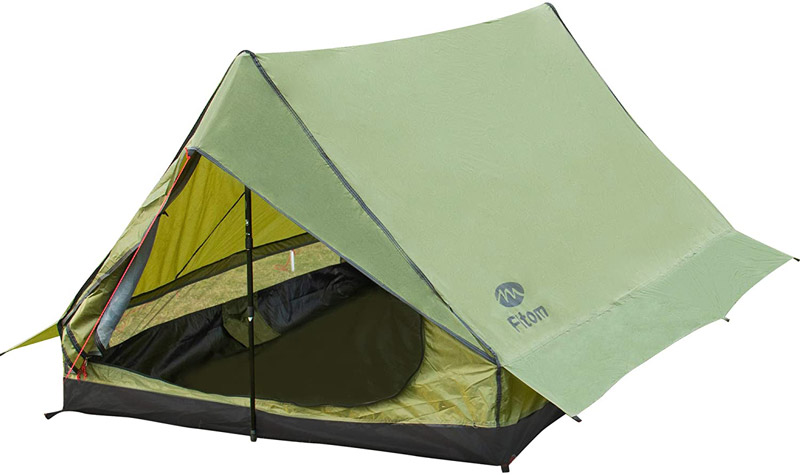
Key Features:
| Capacity: | 2 Person |
| Weight: | 3.6 lbs |
| Floor Size: | 6.9 ft x 4.9 ft |
| Material: | Polyester rainfly, polyurethane base |
| Weather: | Waterproof (3000mm base, 2000mm shell) |
| Extra Features: | Snow skirt, double doors, ventilation |
| Price: | $59.99 |
Additional Thoughts:
Similar to the River Country tent above, this Fltom tent also prioritizes floorspace, with a 4.9 foot width. Entry points can be found on both sides of the tent, with both with generously sized doors.
This tent increases its level of waterproofing across the base of the tent. The bottom of the tent also comes with a snow skirt, whilst the outer layer fans out to promote water runoff away from the tent; making for a multi-season tent.
The drawbacks of this tent being that it is one of the heaviest in weight, and although it has a small awning, it is also without vestibules.
In a Nutshell: Most dynamic base-level tent option
Summary
Tents are one of the most important items you can take with you into the backcountry, and should be given careful consideration when choosing which one best suits your needs.
hiking pole tents add extra practicality as a result of weight saving, space saving and cost saving and come in a variety of designs for different camping requirements.
Weighing up the weather conditions in which you’ll be camping, the amount you can carry on your back and how much space you’ll need in your tent will help you to choose the best hiking tent pole for your camping adventures.
You cannot underestimate the value of a decent night sleep.
